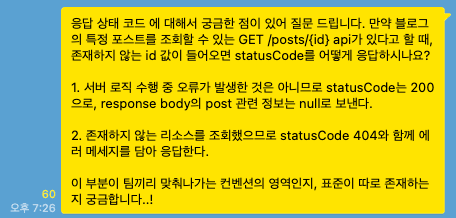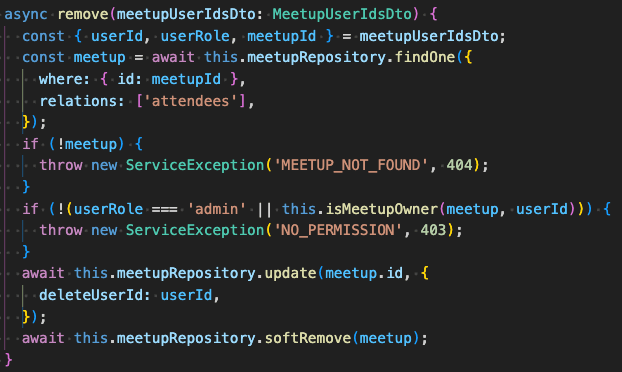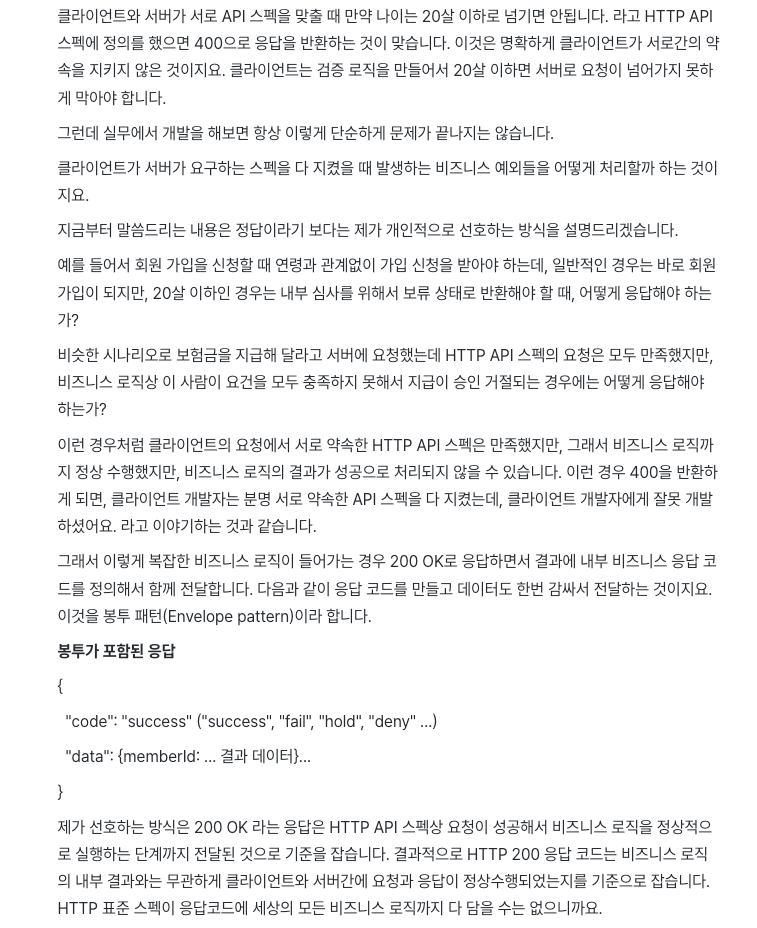NestJS - 비즈니스 로직 에러 핸들링
— NestJS, Exception — 5 min read
비즈니스 로직 에러의 응답

만약 API 스펙을 전부 맞췄지만 비즈니스 로직에서 에러가 발생한다면, 어떤 응답을 내려줘야할까요?
궁금증이 생겨 개발자들이 모인 SNS에 질문을 드렸더니 다양한 답변을 받을 수 있었습니다.
- 케이스 바이 케이스. 맥락과 컨벤션 차이!
- 좀 더 효율적인 모니터링을 위해 성공(200번대) 응답을 내려준다.
- 정답은 없다. 리소스 관점에선 404, 서비스 관점에서는 200으로 볼 수 있다.
그리고 인프런 질문 게시판에서도 관련된 글을 찾을 수 있었습니다.
이러한 고민을 하면서 한가지를 결심하게 되었습니다.
'비즈니스 로직에서 발생하는 에러를 분리해야겠다..!'
API 스펙과 달라 발생하는 오류와 결이 다르기도 하고, 로깅이나 모니터링 방식에 차이를 둘 수도 있기 때문입니다.
그리고 NestJS - 효과적인 예외 핸들링에서 비즈니스 로직 에러를 분리하는 것이 결합도를 낮추고 단일 책임 원칙도 준수할 수 있는 방법이라고 소개합니다.
ServiceException
먼저, 비즈니스 로직 발생 시 사용할 ServiceException을 만들어 줍니다.
ServiceException은 Error를 상속받아 만들었고, 저의 경우 HttpException과 유사하게 만들었습니다.
export enum ErrorMessage { NO_PERMISSION = '권한이 없습니다.', MEETUP_NOT_FOUND = '존재하지 않는 이벤트입니다.', MEETUP_NOT_FOUND_OR_CLOSED = '존재하지 않거나 마감된 이벤트입니다.', MEETUP_REGISTRATION_NOT_FOUND = '해당 이벤트에 신청한 내역이 없습니다.', MEETUP_REGISTRATION_ALREADY_EXIST = '이미 신청한 이벤트 입니다.', TOO_MANY_MEETUP_TEAM_NUMBER = '신청 인원보다 팀 개수가 많습니다.',
USER_NOT_FOUND = '존재하지 않는 유저입니다.',
HASH_TOKEN_ERROR = 'HASH_TOKEN_ERROR'}
export type KeyOfErrorMessage = keyof typeof ErrorMessage;import { ErrorMessage, KeyOfErrorMessage } from '../enum/error-message.enum';
export class ServiceException extends Error { private readonly status: number; private readonly errorCode: string;
constructor(errorCode: KeyOfErrorMessage, status: number, message?: string) { super(message || ErrorMessage[errorCode]); this.name = errorCode; this.status = status; this.errorCode = errorCode; }
getStatus() { return this.status; }
getErrorCode() { return this.errorCode; }
getMessage() { return this.message; }}특정 이벤트를 삭제하는 API에서 ServiceException 사용하기

ServiceExceptionFilter
ServiceException 발생시 잡아줄 ExceptionFilter도 하나 만들어야합니다.
@Catch(ServiceException) 데코레이터를 사용하여 ServiceException 만 잡아내는 ServiceExceptionFilter 를 만들 수 있으며, 응답을 변경할 수도 있습니다.
import { ArgumentsHost, Catch, ExceptionFilter, Logger } from '@nestjs/common';import { ServiceException } from '../exception/service.exception';
@Catch(ServiceException)export class ServiceExceptionFilter implements ExceptionFilter { private readonly logger = new Logger(ServiceExceptionFilter.name);
catch(exception: ServiceException, host: ArgumentsHost) { const ctx = host.switchToHttp(); const response = ctx.getResponse(); const status = exception.getStatus();
response.status(status).json({ statusCode: status, errorCode: exception.getErrorCode(), message: exception.getMessage(), }); }}LogInterceptor
추가로 저는 에러 로깅을 하기 위한 Interceptor도 하나 구현했습니다.
내가 예상하지 못한 에러인 경우 슬랙으로 에러 내용을 전송합니다!
다만 에러 로깅의 경우 로깅의 책임이 에러 필터에 있는지, 인터셉터에 있는지는 좀 더 고민해보려 합니다.
import { CallHandler, ExecutionContext, HttpException, Injectable, Logger, NestInterceptor,} from '@nestjs/common';import { Observable, catchError } from 'rxjs';import { ServiceException } from '../exception/service.exception';import { UnknownException } from '../exception/unknown.exception';import { SlackService } from 'nestjs-slack';import { Message } from 'slack-block-builder';import { ConfigService } from '@nestjs/config';
@Injectable()export class LogInterceptor implements NestInterceptor { private readonly logger = new Logger(LogInterceptor.name);
constructor( private slackService: SlackService, private configService: ConfigService, ) {}
intercept(context: ExecutionContext, next: CallHandler<any>): Observable<any> { const request = context.switchToHttp().getRequest();
return next.handle().pipe( catchError((err) => { const log = `${request.method} ${request.url} - ${err.stack}`; this.logger.error(log); if (err instanceof ServiceException || err instanceof HttpException) { throw err; } this.slackService.postMessage( Message({ text: log, channel: this.configService.get('slack.jiphyeonjeonChannel'), }).buildToObject(), ); throw new UnknownException(err); }), ); }}
